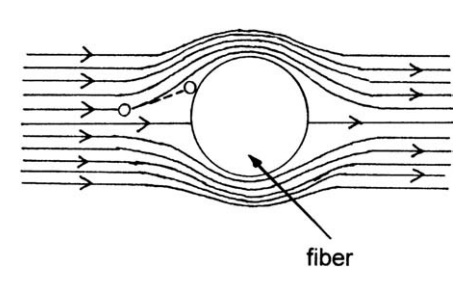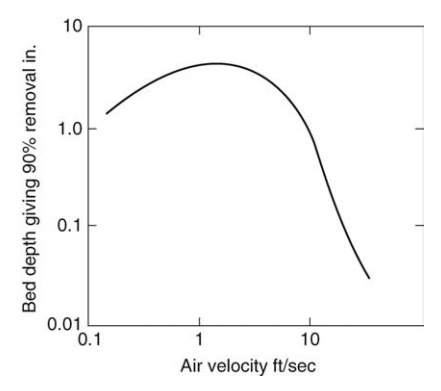The Filtration of Air
| Home | | Pharmaceutical Technology |Chapter: Pharmaceutical Engineering: Filtration
Removal of particulate matter from air together with control of humidity, temperature, and distribution comprise air conditioning.
THE FILTRATION OF AIR
Removal
of particulate matter from air together with control of humidity, temperature,
and distribution comprise air conditioning. Solid and liquid par-ticles are
most commonly arrested by filtration, although other methods, such as electrostatic
precipitation, cyclones, and scrubbers, are used in some circum-stances. The
objective may be simply the provision of comfortable and healthy conditions for
work or may be dictated by the operations proceeding in the area. Some
industrial processes demand large volumes of clean air.
In
this section, we shall be concerned mainly with air filtration, the objective
of which is the reduction in number or complete removal of bacteria. This is
applied, with varying stringency, to several operations associated with
pharmacy. Where sterilization is the objective and the presence of inanimate
particles is of secondary importance, other methods, such as ultraviolet
radia-tion and heating, must be added.
Bacteria
rarely exist singly in the atmosphere but are usually associated with much
larger particles. For example, it has been shown that 78% of particles carrying
Clostridium welchii were greater than 4.2 x 10-6 m. The average
diameter exceeded 10 x 10-6 m. On this basis, it has been suggested
that air filters that are 99.9% efficient at 5 x10-6 m are adequate
for filtration of air supplied to operating theaters and dressing wards
(Williams et al., 1961). On the other hand, filters used to clean air supplied
to large-scale aerobic fermentation cultures must offer a very low probability
that any organism will penetrate during the process. This became important in
the deep-culture production of penicillin when the ingress of a single
penicillinase-producing organism could be disastrous. Similarly, stringent
conditions are laid down for the supply of air to areas where sterile products
are prepared and handled.
The Mechanism of Air Filtration
A
theoretical foundation for the filtration of air by passage through fibrous
media was laid in the early 1930s by studies of the flow of suspended particles
around various obstacles. In studies of the filtration of smokes (Suits, 1961;
Hinds, 1999), it has been shown that a number of factors operate simultaneously
in the arrest of a particle during its passage through a filter, although their
relative importance varies with the type of filter and the conditions under
which it is operated. These factors may be listed as follows:
·
Diffusion effects due to Brownian movement
·
Electrostatic attraction between particles and fibers
·
Direct interception of a particle by a fiber
·
Interception as a result of inertial effects acting on a
particle and causing it to collide
with a fiber
·
Settling and gravitational effects

FIGURE 11.6 Inertial capture of a particle
by a fiber.
Air
filters operate under conditions of streamline flow, as indicated by the
streamlines drawn around a cylindrical fiber shown in cross section in Figure
11.6. It was assumed that capture of a particle takes place if any contact is
made during its movement around the fiber. Once capture occurs, the particle is
not re-entrained in the airstream and is deposited deeper in the bed. Support
for this assumption has been found by using an atomized suspension of
Staphylococcus albus and spores of Bacillus subtilis (Terjesen and Cherryl,
1947). Nevertheless, some fiber filters are treated with viscous oils,
presumably to make capture more positive and to reduce re-entrainment.
If
a particle remains in a streamline during passage around the fiber, capture
will occur only if the radius of the particle exceeds the distance between
streamline and fiber, a dimension dependent on the diameters of the particle
and the fiber. This mechanism, termed “capture by direct interception,” is
independent of the air velocity except in so far as the streamlines are
modified by changes in air velocity.
Deviation
of particles from streamlines can occur in a number of ways (Hinds, 1999;
Reist, 1993). The chance of capture will increase if Brownian movement causes
appreciable migration across streamlines, an effect only important for small
particles (<5 x 10-7
m) and low air speeds, when the time spent in the vicinity of a fiber is
relatively large. These conditions also apply to capture, which is the result
of electrostatic attraction.
The
inertial mechanism depends on the mass of the particle, the fiber diameter, and
the velocity of approach. The particle deviates from the streamline and follows
the broken line shown in Figure 11.6. Capture occurs if the devia-tion, which
increases as the mass and velocity of the particle increase, brings the
particle into contact with the fiber.
The
simultaneous operation of mechanisms, at least one of which demands low air
speeds and fine particles for effectiveness and another which requires large
particles traveling at high speeds, suggests that maximum penetration could
occur at an intermediate air speed. Conversely, there is, for any given
conditions, an optimal particle size for which the combined filtration effects
are a minimum and penetration is a maximum. The former was confirmed with a
variety of inanimate aerosols. A diagrammatic representation of the interaction
of mecha-nisms was also given, and this is reproduced in Figure 11.7.
Similar
effects were demonstrated for bacterial aerosols (Humphrey and Gaden, 1956).
Estimated the efficiency with which a glass fiber mat collected

FIGURE 11.7 Interaction of the mechanisms
of particle arrest.

FIGURE 11.8 Effect of airstream velocity on the removal of bacterial spores by a filter.
The Design, Operation, and Testing of Air Filters
Granular
beds, fibrous media, and “absolute filters” prepared from cellulose and
asbestos are used for high-efficiency air filtration. With fibrous and granular
filters, the fractional reduction in particle content is assumed to be the same
through successive incremental thicknesses of the filter. We may, therefore,
rewrite equation (2).

where
C represents the number of particles entering a section of thickness dx. The constant, k, is a measure of the filter’s ability to retain a particle and is
a complex function of fiber diameter, interfiber distance, and operational air
velocity. Integration between inlet and outlet conditions gives

The
use of this log penetration effect in filter design has been described
else-where (Gaden and Humphrey, 1955). If a certain filter thickness is capable
of retaining 90% of the entering particles, then if 106 particles
enter, 105 will pen-etrate. If six thicknesses are used, then the
relation above predicts that only one particle will penetrate. The log
penetration effect has been confirmed for fibrous filters and for granular beds
(Humphrey and Gaden, 1956; Cherry et al., 1951), respectively. It must be
stressed, however, that both fibrous and granular filters present passages very
much greater than the fine particles they remove. Abso-lute sterility or
absolute filtration at a certain particle size cannot be achieved. However, design
variables, such as the fiber diameter, the density with which fibers are
packed, the thickness of the filter, and the air speed. For example, these
variables may be varied to give air that, for a given input contamination, is,
with a high statistical probability, sterile.
In
an early study, Terjesen and Cherryl used a bacterial aerosol and a Bourdillon
slit sampler to test the suitability of filters for air sterilization (Terjesen
and Cherryl, 1947). They showed that 0.075-m slabs of slag wool composed of
fibers, most of which were less than 6 x 10-6 m and compressed to a
suitable density, gave sterile air when operated for fifteen days at a face
velocity of 0.152 m/sec. A similar efficiency was found for filters composed of
glass fibers of similar diameters (Cherry et al., 1951). Resin-bonded filter
mats composed of glass fibers, 12 x 10-6 to 13 x 10-6 m
in diameter, have also been described. A number of these mats assembled to give
a filter 0.304 m deep were effective in the removal of bacteria.
Bacteria
may be effectively removed by passing air through deep granular beds of
activated carbon, alumina, and other materials. Table 11.1 gives data on the
efficiency of alumina in a bed 0.381 m deep for the removal of Serratia
marcescens from air (Sykes and Carter, 1954). The effect of two design
variables, granule size and air speed, is illustrated.
The
extremely hazardous nature of radioactive dusts has promoted the design of
high-efficiency air filters for use in establishments where such mate-rials are
handled. These filters may be used for any application requiring extremely pure
air. The evolution of filters that remove 99.995% of particles in the range 1 x
10-7 to 5 x 10-7 m has been described by White and Smith
(White and Smith, 1960). A medium in paper form was constructed from cellulose
and asbestos. This could be pleated round corrugated spacers to give a large
filtering area in a relatively small space. A paper composed of very fine glass
fibers was
TABLE 1 Removal of Serratia marcescens
with a 0.3-m Bed of Alumina Granules

The
general object of design in all filters is the virtual certainty of removing
the particles under consideration with a medium offering minimal resistance to
the flow of air. Unlike liquid clarifiers, air filters become more efficient
with time because accumulation of particles restricts the passages through the
medium. This deposition causes an increase in the pressure differential
required to maintain a given flow rate. When the filter has become laden with a
certain amount of dust, it must be cleaned or replaced. The life of
high-efficiency air filters may be lengthened by passing the air first through
a coarse or “roughing” filter, which removes the larger particles.
The
use of bacterial aerosols as tracer organisms to test the efficiency of filters
has already been described. Other tests with inanimate dusts are more generally
used for the evaluation of filter performance. For general ventilation
purposes, two tests are specified. The first determines gravimetrically the
capacity of the filter to hold dust and still function satisfactorily. A
standard dust of 5 x 10-6 or 26 x 10-5 m is passed into
the filter until a specified increase in air flow resistance occurs. The second
test, which is also applicable to high-efficiency filters, determines the
fraction of a methylene blue aerosol that passes through the filter under given
conditions. The aerosol is generated by atomizing a 1% aqueous solution of
methylene blue. The droplets dry to give a cloud of particles, 90% of which are
below 2 x 10-7 m. The test is, therefore, extremely stringent. The
cloud is passed through the filter at a constant rate (10-3 m3/min)
and then through a strip of porous paper, which collects any methylene blue
particles that have penetrated. The stain due to the dye, after intensification
in steam, is compared with a series of similar stains that correspond to known volumes
of unfiltered air. Thus, if 60 x 10-3 m3 of filtered air
gives a stain that matches that produced by 1.2 x 10-5 m3
of unfiltered air, the penetration is 0.02% (Green and Lane, 1957). Both tests
are fully described in BS 2831:1957. An alternative method of evaluating
penetration employs a cloud produced by the atomization of a solution of sodium
chloride. After passage through the filter, part of the air is passed through a
hydrogen flame. The intensity of the sodium flame produced is estimated with a
photoelectric cell.
Related Topics
